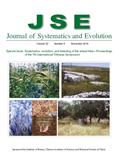Li-Na SHA, Xing FAN, Hai-Qin ZHANG, Hou-Yang KANG, Yi WANG, Xiao-Li WANG, Li ZHANG, Chun-Bang DING, Rui-Wu YANG, Yong-Hong ZHOU
Leymus Hochst. is a polyploid genus with a diverse array of morphology, cytology, ecology, and distribution in Triticeae. To investigate the phylogenetic relationships and maternal genome donor of polyploid Leymus, the chloroplast trnH-psbA region and mitochondrial coxII intron sequences of 33 Leymus taxa were analyzed with those of 36 diploid perennial species representing 19 basic genomes in Triticeae. The results showed that reticulate evolution occurred in Leymus species, with the cytoplasmic lineage of Leymus contributed by different progenitors. Interspecific relationships of Leymus were also elucidated on the basis of orthologous comparison. Our data suggested that: (i) due to incomplete lineage sorting and/or difference in the pattern of chloroplast and mitochondrial inheritance, the genealogical conflict between the two genealogical patterns suggest the contribution of Psathyrostachys Nevski, Agropyron J. Gaertn, Eremopyrum (Ledeb.) Jaub. & Spach, Pseudoroegneria (Nevski) Á. Löve, Thinopyrum Á. Löve, and Lophopyrum (Host) Á. Löve to the cytoplasmic lineage of Leymus; (ii) there is a close relationship among Leymus species from the same area or neighboring geographic regions; (iii) L. coreanus (Honda) K. B. Jensen & R. R.-C. Wang, L. duthiei (Stapf) Y. H. Zhou & H. Q. Zhang ex C. Yen, J. L. Yang & B. R. Baum, L. duthiei var. longearistatus (Hack.) Y. H. Zhou & H. Q. Zhang ex C. Yen, J. L. Yang & B. R. Baum, and L. komarovii(Roshev.) C. Yen, J. L. Yang & B. R. Baum are closely related to other Leymus species, and it is reasonable to transfer these species from the genus Hystrix Moench to Leymus; (iv) Leymus species from North America are closely related to L. coreanus from the Russian Far East and L. komarovii from northeast China but are evolutionarily distinct from Leymus species from Central Asia and the Qinghai–Tibet Plateau. The occurrence of multiple origin and introgression could account for the rich diversity and ecological adaptation of Leymus species.


